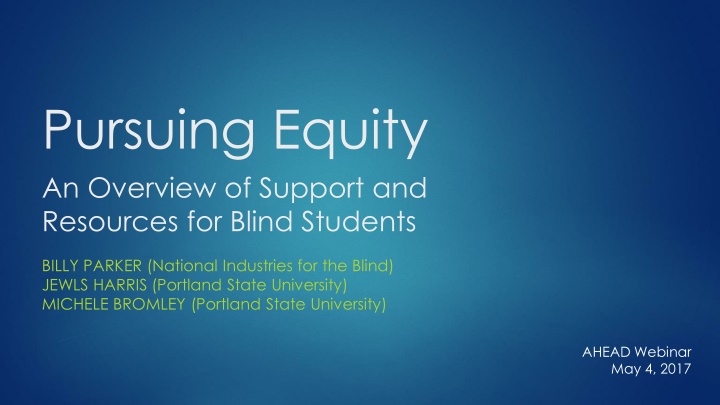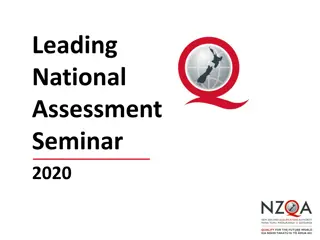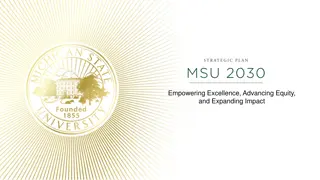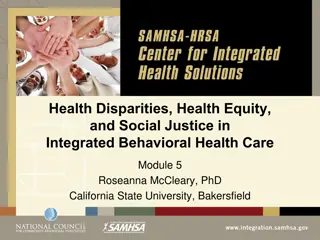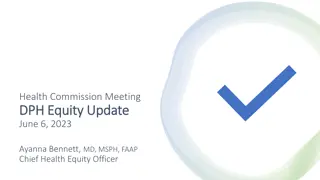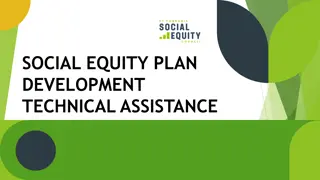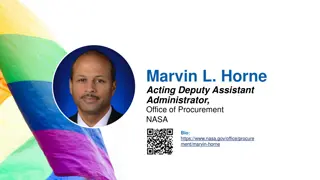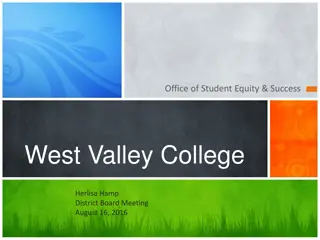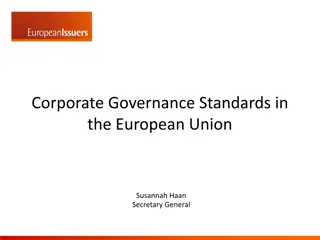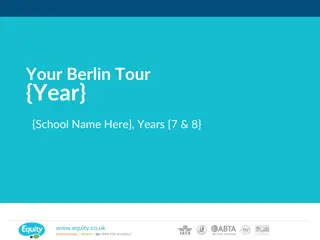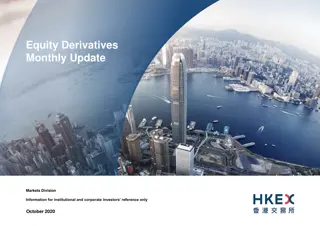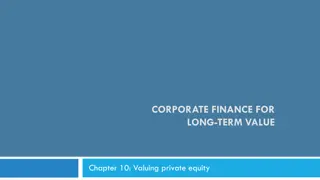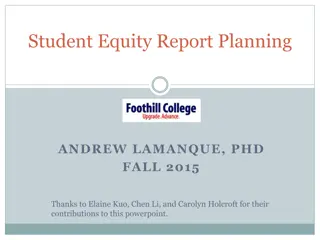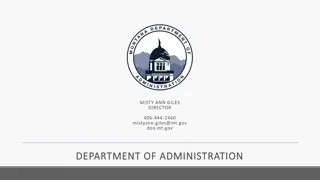Pursuing Equity
This content delves into the pursuit of equity for blind students, covering topics such as ADA compliance, accessible materials, reasonable accommodations, regulations, case law, common pitfalls, and using an equity lens. It emphasizes the importance of adjusting the social environment to meet the needs of disabled individuals. The goal is equity, not just equal access.
Download Presentation

Please find below an Image/Link to download the presentation.
The content on the website is provided AS IS for your information and personal use only. It may not be sold, licensed, or shared on other websites without obtaining consent from the author.If you encounter any issues during the download, it is possible that the publisher has removed the file from their server.
You are allowed to download the files provided on this website for personal or commercial use, subject to the condition that they are used lawfully. All files are the property of their respective owners.
The content on the website is provided AS IS for your information and personal use only. It may not be sold, licensed, or shared on other websites without obtaining consent from the author.
E N D
Presentation Transcript
Pursuing Equity An Overview of Support and Resources for Blind Students BILLY PARKER (National Industries for the Blind) JEWLS HARRIS (Portland State University) MICHELE BROMLEY (Portland State University) AHEAD Webinar May 4, 2017
Agenda ADA compliance Using an equity lens Accessible materials and online access In-class and supplemental supports Resources for transition and employment
Reasonable Accommodations and ADA Compliance
Regulations Section 504 of the Rehabilitation Act of 1973 Americans with Disabilities Act Amendments Act (ADAAA) Chaffee Amendment
Case Law Online accessibility cases (University of Montana, Florida State University, UC Berkeley, Penn State University) Accessible technology cases (Arizona State University, Miami University) Student preference and comprehensive services (Dudley v. Miami University)
Common Pitfalls in Compliance Efforts Creating a one-size-fits-all approach to the needs of blind/visually impaired students If the student doesn t request an accommodation for a specific aspect of the course, the problem is left unexplored If the course is accessible, no additional support is offered.
Disability stems from the failure of a structured social environment to adjust to the needs and aspirations of disabled citizens rather than from the inability of a disabled individual to adapt to the demands of society. In viewing disability as a product of a dynamic interaction between humans and their surroundings, emphasis is shifted from the individual to the broader social, cultural, economic, and political environment. In fact, from this perspective, disability may even be regarded primarily as the consequence of a disabling environment . Using the socio- political model of disability - Harlan Hahn
Equity, not equality, is the goal Equal access isn t actually equitable 1. Equity means providing more to some to establish a level playing field for all 2. Equity means taking usability and inclusion, not just accessibility, into consideration when making decisions
Social Justice Framework: Basically, a social justice framework is a way of seeing and acting aimed at resisting unfairness and inequity while enhancing freedom and possibility for all. It pays primary attention to how people, policies, practices, curricula, and institutions may be used to liberate rather than oppress those least served by our decision-making. Social Justice requires full inclusion and participation Advocacy Leadership Empowerment Social Change
By and large, blind people are taught to be dependent on sighted people in part because 99% of them are taught by people who can see. My biggest barrier is people; Especially sighted people. Independence is the goal. -Daniel Kish, Blind A graduated, holistic model is key to success.
Collaboration: Consistent One-on-One Collaboration with student Case management Individualized short term and long term goals Accommodations evolve as students set new, more advanced goals Long term goals lead to greater independence and translate to real- world environments Weekly follow up meetings until less frequent meetings are indicated
Accessible Materials and Online Content
Communication and Coordination with Faculty Communicating Early Introductory email from the Director Follow-up emails from the responsible DS provider Midterm email from the responsible DS provider End-of-term email from the responsible DS provider Explaining Clearly Outlining DS responsibilities versus faculty responsibilities Explaining how and when materials and information must be shared Reminding Often
Acquisition and Conversion of Materials Assessing students formats needs Administering an Adaptive Technology Needs Assessment Understanding different formats: BRF, DOCX, MP3, Tactile, XHT, etc. Working with publishers Obtaining an electronic copy Assessing accessibility Converting to accessible formats Acquiring the appropriate tools and training, or Establishing a relationship with a quality vendor
Acquisition and Conversion of Materials Equipment Requirements for in-House Conversion Book Cutter Braille Translation Software Quality Duplex Scanner MP3 Converter w/Math Capability OCR Software (Text and Music) Music Notation Editor Adobe Acrobat Pro Music Braille Translator Microsoft Word Braille Embosser Accessible Equation Editor Tactile Graphic Maker
Acquisition and Conversion of Materials Vendor Categories for Outsourcing Conversion Accessible Text Conversion Accessible Tactile Conversion Accessible Music Conversion Accessible Video Conversion
Assessment of Software and Online Spaces Testing accessibility via screen reading software Understanding JAWS, NVDA, and/or VoiceOver Supporting students with outside-of-the-box navigation Scheduling follow-up appointments for navigation training Connecting students to regional and community supports Working with faculty on alternative accommodations Thinking outside-of-the-box for software alternatives
Questions? Email templates, equipment lists, vendor recommendations, and basic conversion procedures will be made available via the AHEAD Blind and Low Vision SIG website.
In-Class and Supplemental Supports
Supplementary Support: Provided by Classroom Assistants and Auxiliary Support Extensive annual training for classroom assistants Visits to more problematic courses to provide feedback to the faculty and supervise classroom assistants Ongoing support and collaboration with faculty Responsive, creative solutions with classroom access, testing arrangements, course assignments, and other issues as needed
Resources: Robust and Intensive Resources and Assistance Provided to Faculty Faculty handbook details alternative format procedures and in-class instruction guidance Video describing how to provide an accessible and welcoming classroom Checklist to determine course accessibility needs Consultation meetings with faculty, students, and assistants as needed
Engagement: Early and Thorough Engagement with Community Partners Collaboration with vocational rehabilitation programs such as the Oregon Commission for the Blind (OCB) Joint meetings with the student, OCB counselor, and PSU staff to establish needs early in the admissions process On-going coordination to ensure technology training and student development goals are consistent with vocational goals Community referrals and assistance accessing private training and supports when other agencies not involved
Questions? Email templates, classroom assistant training materials, and checklists will be available via the AHEAD Blind and Low Vision SIG website.
Resources for Transition and Employment
Resources: Transition and Employment Workforce Recruitment Program https://wrp.gov US Business Leaders Network https://usbln.org National Industries for the Blind https://NIB.org American Foundation for the Blind https://afb.org
Resources: Transition and Employment American Council of the Blind https://acb.org National Federation of the Blind https://nfb.org Equal Opportunity Publications https://eop.org Getting Hired https://gettinghired.com
Questions? A complete list of transition and employment resources will be available via the AHEAD Blind and Low Vision SIG website.
Using an equity lens and foundation in social justice, the Blind and Low Vision SIG provides supports and resources to DS offices in order to increase equity and access for students who are blind and low vision. The SIG provides information and resources on several topics including: Equitable approaches to services, In-class and auxiliary supports, Accessible materials and online access, and Transition and employment. Visit the AHEAD Blind and Low Vision SIG at http://www.ahead.org/sigs/blind-and-low-vision.
Thank you for attending!! The Blind and Low Vision SIG hopes to offer an expanded series of webinars next academic year. Stay tuned.
Billy Parker Co-Chair, AHEAD Blind and Low Vision SIG Program Director, Employment Support Services National Industries for the Blind bparker@nib.org Jewls Harris, Co-Chair AHEAD Blind and Low Vision SIG Access Counselor & Consultant Portland State University jewls.harris@pdx.edu Michele Bromley Adaptive Technology Specialist & Alternative Formats Coordinator Portland State University michele.bromley@pdx.edu
